Application of Combined Micro- and Macro-Scale Models to Investigate Heat and Mass Transfer through Textile Structures with Additional Ventilation
Abstract
1. Introduction
2. Materials and Methods
2.1. The Representative Volume Element
2.2. Mathematical Model and Assumptions
2.2.1. Determination of Thermal Resistance
2.2.2. Mesh Analysis
2.3. Development of a Micro-Scale Model
| Algorithm 1. Pseudocode of Newton’s method for nonlinear equations. |
| 1: Choose a starting guess x0 and accuracy є. 2: for k = 0, 1, 2, … do 3: compute the correction Solve by the direct solver. 4: update the solution guess . 5: if < є then 6: stop. 7: end if 8: end for Note. For highly nonlinear problems, a damped update of the form can be used, with 0 < α < 1 where α is a damping parameter. |
2.4. The Macro-Scale Model
3. Results and Discussion
3.1. Mesh Analysis
3.2. Thermal Resistance Evaluation at a Micro-Scale
3.3. Combined Forced Ventilation Micro- and Macro-Scale Models
4. Conclusions
Author Contributions
Funding
Data Availability Statement
Conflicts of Interest
References
- Li, Y. The science of clothing comfort. Text. Prog. 2001, 31, 1–135. [Google Scholar] [CrossRef]
- Zhang, C.; Wang, F. Comfort Management of Fibrous Materials 31.2 Human Thermal Regulation and Heat Transfer; Wiley: Hoboken, NJ, USA, 2020; pp. 857–887. [Google Scholar]
- Tessier, D. Testing Thermal Properties of Textiles; Elsevier Ltd.: Amsterdam, The Netherlands, 2017. [Google Scholar]
- Barauskas, R.; Baltušnikaite, J.; Abraitiene, A.; Grinevičiute, D. Experimental investigations and finite element model of heat and moisture transfer in multilayer textile packages. Fibres Text. East. Eur. 2012, 95, 112–118. [Google Scholar]
- Angelova, R.A.; Kyosov, M.; Stankov, P. Numerical investigation of the heat transfer through woven textiles by the jet system theory. J. Text. Inst. 2019, 110, 386–395. [Google Scholar] [CrossRef]
- Das, T.; Das, A.; Alagirusamy, R. Study on thermal protective performance of thermal liner in a multi-layer clothing under radiant heat exposure. J. Ind. Text. 2022, 51, 8208S–8226S. [Google Scholar] [CrossRef]
- Goldstein, R.; Eckert, E.; Ibele, W.; Patankar, S.; Simon, T.; Kuehn, T.; Strykowski, P.; Tamma, K.; Heberlein, J.; Davidson, J.; et al. Heat transfer—A review of 2001 literature. Int. J. Heat Mass Transf. 2003, 46, 1887–1992. [Google Scholar] [CrossRef]
- Zhang, J.; Chauhan, S. Fast explicit dynamics finite element algorithm for transient heat transfer Jinao Zhang, Sunita Chauhan Department of Mechanical and Aerospace Engineering, Monash University, Wellington Rd, Clayton, Melbourne, VIC 3800, Australia. Int. J. Therm. Sci. 2019, 139, 160–175. [Google Scholar] [CrossRef]
- Udayraj; Talukdar, P.; Das, A.; Alagirusamy, R. Heat and mass transfer through thermal protective clothing—A review. Int. J. Therm. Sci. 2016, 106, 32–56. [Google Scholar] [CrossRef]
- Fan, J.; Luo, Z.; Li, Y. Heat and moisture transfer with sorption and condensation in porous clothing assemblies and numerical simulation. Int. J. Heat Mass Transf. 2000, 43, 2989–3000. [Google Scholar] [CrossRef]
- Xu, D.H.; Ge, M.B.; Zhang, H.L. Numerical solution of a dynamic model of heat and moisture transfer in porous fabric under low temperature. Int. J. Heat Mass Transf. 2013, 61, 149–157. [Google Scholar] [CrossRef]
- Li, Y.; Luo, Z.X. Physical mechanisms of moisture diffusion into hygroscopic fabrics during humidity transients. J. Text. Inst. 2000, 91, 302–316. [Google Scholar] [CrossRef]
- Li, Y.; Zhu, Q. A model of coupled liquid moisture and heat transfer in porous textiles with consideration of gravity. Numer. Heat Transf. Part A: Appl. 2003, 43, 501–523. [Google Scholar] [CrossRef]
- Madhu, M.; Kishan, N. Finite element analysis of heat and mass transfer by MHD mixed convection stagnation-point flow of a non-Newtonian power-law nanofluid towards a stretching surface with radiation. J. Egypt. Math. Soc. 2016, 24, 458–470. [Google Scholar] [CrossRef]
- Simões, N.; Tadeu, A.; António, J.; Mansur, W. Transient heat conduction under nonzero initial conditions: A solution using the boundary element method in the frequency domain. Eng. Anal. Bound. Elem. 2012, 36, 562–567. [Google Scholar] [CrossRef]
- Long, G.; Liu, Y.; Xu, W.; Zhou, P.; Zhou, J.; Xu, G.; Xiao, B. Analysis of Crack Problems in Multilayered Elastic Medium by a Consecutive Stiffness Method. Mathematics 2022, 10, 4403. [Google Scholar] [CrossRef]
- Gholamreza, F.; Su, Y.; Li, R.; Nadaraja, A.V.; Gathercole, R.; Li, R.; Dolez, P.I.; Golovin, K.; Rossi, R.M.; Annaheim, S.; et al. Modeling and Prediction of Thermophysiological Comfort Properties of a Single Layer Fabric System Using Single Sector Sweating Torso. Materials 2022, 15, 5786. [Google Scholar] [CrossRef] [PubMed]
- Acharya, J.; Dinda, A.; Bhanja, D.; Misra, R.D.; Nath, S. Influence of aging and body location on the thermal performance of firefighter’s clothing exposed to radiant heat source. Int. J. Therm. Sci. 2023, 184, 108024. [Google Scholar] [CrossRef]
- Lim, J.; Choi, H.; Roh, E.K.; Yoo, H.; Kim, E. Assessment of airflow and microclimate for the running wear jacket with slits using CFD simulation. Fash. Text. 2015, 2, 1–13. [Google Scholar] [CrossRef]
- Sun, Y.; Jasper, W.J. Numerical modeling of heat and moisture transfer in a wearable convective cooling system for human comfort. Build. Environ. 2015, 93, 50–62. [Google Scholar] [CrossRef]
- Santos, M.S.; Oliveira, D.; Campos, J.B.L.M.; Mayor, T.S. Numerical analysis of the flow and heat transfer in cylindrical clothing microclimates—Influence of the microclimate thickness ratio. Int. J. Heat Mass Transf. 2018, 117, 71–79. [Google Scholar] [CrossRef]
- Xu, P.; Kang, Z.; Wang, F.; Udayraj, U. A numerical analysis of the cooling performance of a hybrid personal cooling system (HPCS): Effects of ambient temperature and relative humidity. Int. J. Environ. Res. Public Health 2020, 17, 4995. [Google Scholar] [CrossRef]
- Siddiqui, M.O.R.; Sun, D. Computational analysis of effective thermal conductivity of microencapsulated phase change material coated composite fabrics. J. Compos. Mater. 2015, 49, 2337–2348. [Google Scholar] [CrossRef]
- Siddiqui, M.O.R.; Sun, D. Conjugate heat transfer analysis of knitted fabric. J. Therm. Anal. Calorim. 2017, 129, 209–219. [Google Scholar] [CrossRef]
- Joshi, A.; Psikuta, A.; Bueno, M.A.; Annaheim, S.; Rossi, R.M. Effect of movement on convection and ventilation in a skin-clothing-environment system. Int. J. Therm. Sci. 2021, 166, 106965. [Google Scholar] [CrossRef]
- Joshi, A.; Psikuta, A.; Bueno, M.A.; Annaheim, S.; Rossi, R.M. Analytical clothing model for sensible heat transfer considering spatial heterogeneity. Int. J. Therm. Sci. 2019, 145, 105949. [Google Scholar] [CrossRef]
- Renard, M.; Puszkarz, A.K. Modeling of Heat Transfer through Firefighters Multilayer Protective Clothing Using the Computational Fluid Dynamics Assisted by X-ray Microtomography and Thermography. Materials 2022, 15, 5417. [Google Scholar] [CrossRef]
- Codau, E.; Codau, T.C.; Lupu, I.G.; Raru, A.; Farima, D. Heat transfer simulation through textile porous media. J. Text. Inst. 2023, 114, 257–264. [Google Scholar] [CrossRef]
- Neves, S.F.; Campos, J.B.L.M.; Mayor, T.S. On the determination of parameters required for numerical studies of heat and mass transfer through textiles—Methodologies and experimental procedures. Int. J. Heat Mass Transf. 2015, 81, 272–282. [Google Scholar] [CrossRef]
- Barauskas, R.; Abraitiene, A. A model for numerical simulation of heat and water vapor exchange in multilayer textile packages with three-dimensional spacer fabric ventilation layer. Text. Res. J. 2011, 81, 1195–1215. [Google Scholar] [CrossRef]
- ISO 11092:2014(en) Textiles—Physiological Effects—Measurement of Thermal and Water-Vapour Resistance under Steady-state Conditions (Sweating Guarded-Hotplate Test). Available online: https://www.iso.org/obp/ui/#iso:std:iso:11092:ed-2:v1:en (accessed on 18 May 2023).
- Liu, Y.; Hu, H. Compression property and air permeability of weft-knitted spacer fabrics. J. Text. Inst. 2011, 102, 366–372. [Google Scholar] [CrossRef]
- Bargmann, S.; Klusemann, B.; Markmann, J.; Schnabel, J.E.; Schneider, K.; Soyarslan, C.; Wilmers, J. Generation of 3D representative volume elements for heterogeneous materials: A review. Prog. Mater. Sci. 2018, 96, 322–384. [Google Scholar] [CrossRef]
- Zupin, Ž.; Hladnik, A.; Dimitrovski, K. Prediction of one-layer woven fabrics air permeability using porosity parameters. Text. Res. J. 2011, 82, 117–128. [Google Scholar] [CrossRef]
- EN ISO 9237:1995; Textiles—Determination of Permeability of Fabrics to Air. Available online: https://www.iso.org/standard/16869.html (accessed on 18 May 2023).
- Gadeikytė, A.; Abraitienė, A.; Barauskas, R. Prediction of air permeability coefficient and water-vapor resistance of 3D textile layer. J. Text. Inst. 2022, 113, 396–404. [Google Scholar] [CrossRef]
- Gadeikytė, A. Multiscale Models and Algorithms for the Simulation of Heat and Moisture Transfer in Textile Structures. Ph.D. Thesis, Kauno Technologijos Universitetas, “Technologija”, Kaunas, Lithuania, 2022. [Google Scholar]
- Leal, L.G. Advanced Transport Phenomena; Cambridge University Press: New York, NY, USA, 2007. [Google Scholar]
- Elgeti, S.; Sauerland, H. Deforming fluid domains within the finite element method. Arch. Comput. Methods Eng. 2014, 23, 323–361. [Google Scholar] [CrossRef]
- COMSOL. COMSOL Multiphysics Reference Manual.Version: COMSOL 5.5; 2018. Available online: https://doc.comsol.com/5.5/doc/com.comsol.help.comsol/COMSOL_ReferenceManual.pdf (accessed on 18 May 2023).
- Sankauskaite, A.; Rubežiene, V.; Kubiliene, D.; Abraitiene, A.; Baltušnikaite-Guzaitiene, J.; Dubinskaite, K. Investigation of thermal behavior of 3D PET knits with different bioceramic additives. Polymers 2020, 12, 1319. [Google Scholar] [CrossRef] [PubMed]
- Tsilingiris, P.T. Thermophysical and transport properties of humid air at temperature range between 0 and 100 °C. Energy Convers. Manag. 2008, 49, 1098–1110. [Google Scholar] [CrossRef]
- Gadeikytė, A.; Sandonavičius, D.; Rimavičius, V.; Barauskas, R. Finite Element Analysis of Heat and Mass Exchange Between Human Skin and Textile Structures. Balt. J. Mod. Comput. 2022, 10, 159–169. [Google Scholar] [CrossRef]
- Martinez, J.M. Algorithms for solving nonlinear systems of Equations. In Algorithms for Continuous Optimization; NATO ASI Series (Series C: Mathematical and Physical Sciences); Springer Publishing: New York, NY, USA, 1994; Volume 434, pp. 81–108. [Google Scholar]
- Schenk, O.; Gärtner, K.; Fichtner, W. Scalable parallel sparse factorization with left-right looking strategy on shared memory multiprocessors. In Lecture Notes in Computer Science (Including Subseries Lecture Notes in Artificial Intelligence and Lecture Notes in Bioinformatics); Springer Publishing: New York, NY, USA, 1999; Volume 1593, pp. 221–230. [Google Scholar]
- Larson, M.G.; Bengzon, F. The Finite Element Method: Theory, Implementation, and Applications (Texts in Computational Science and Engineering); Springer: Berlin/Heidelberg, Germany; New York, NY, USA; Dordrecht, The Netherlands; London, UK, 2013. [Google Scholar]
- Shen, H.; An, Y.; Zhang, H.; Wang, F.; He, Y.; Wang, J.; Tu, L. 3D numerical investigation of the heat and flow transfer through cold protective clothing based on CFD. Int. J. Heat Mass Transf. 2021, 175, 121305. [Google Scholar] [CrossRef]
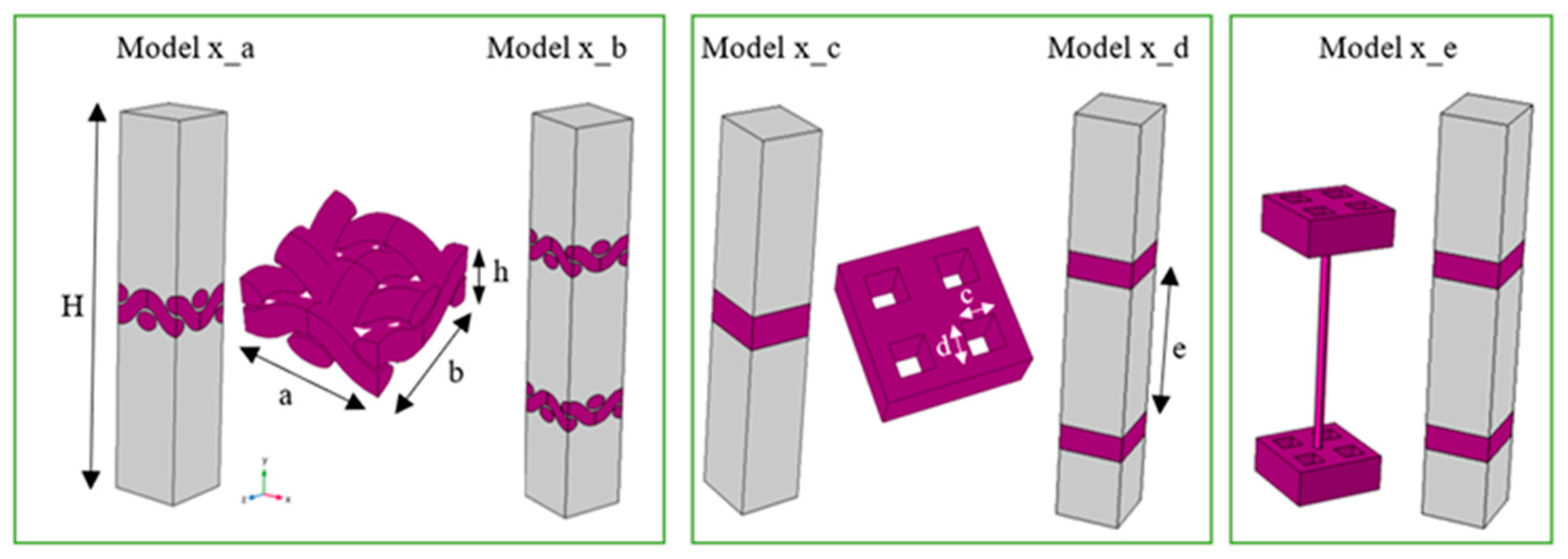


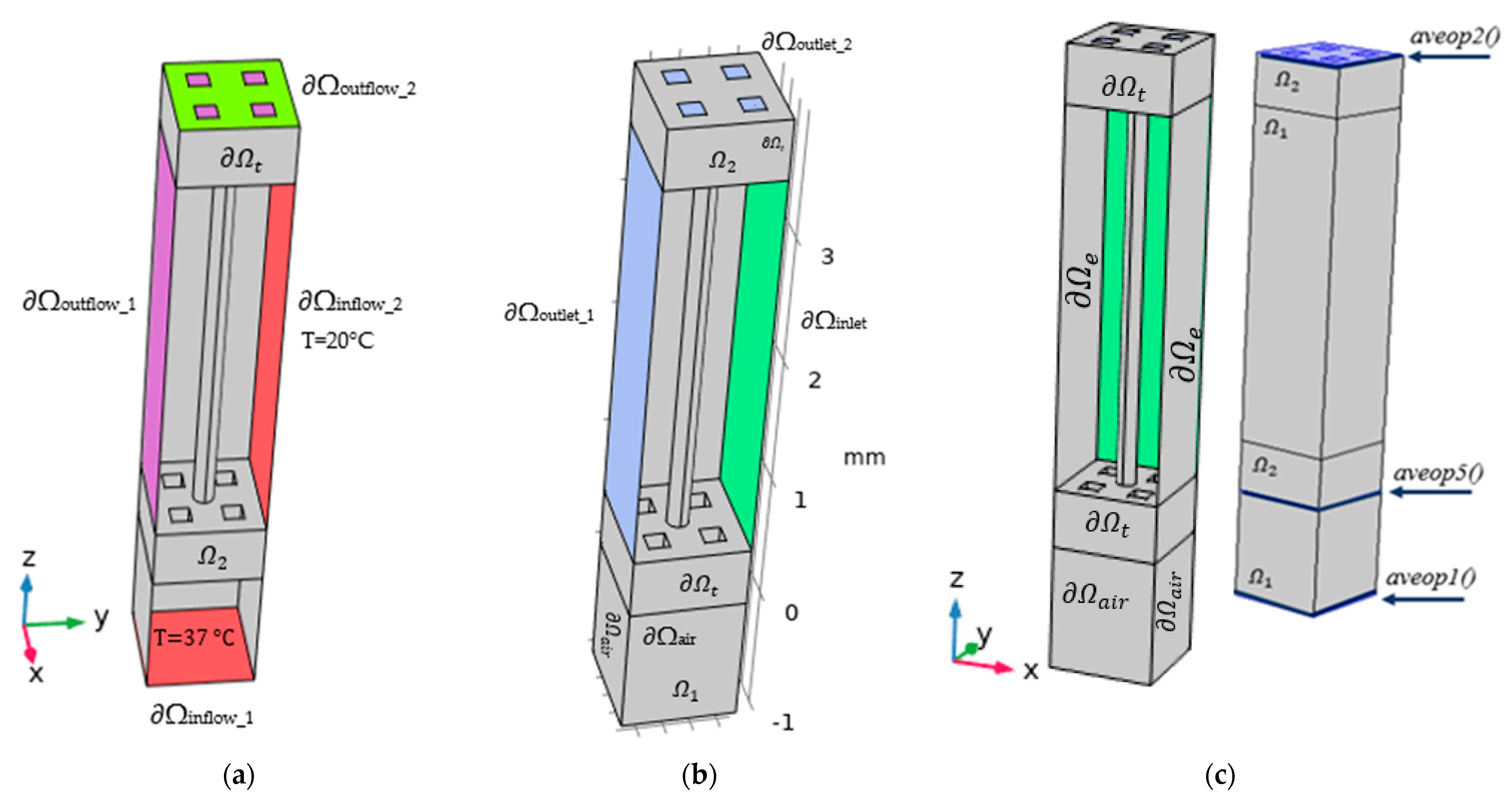
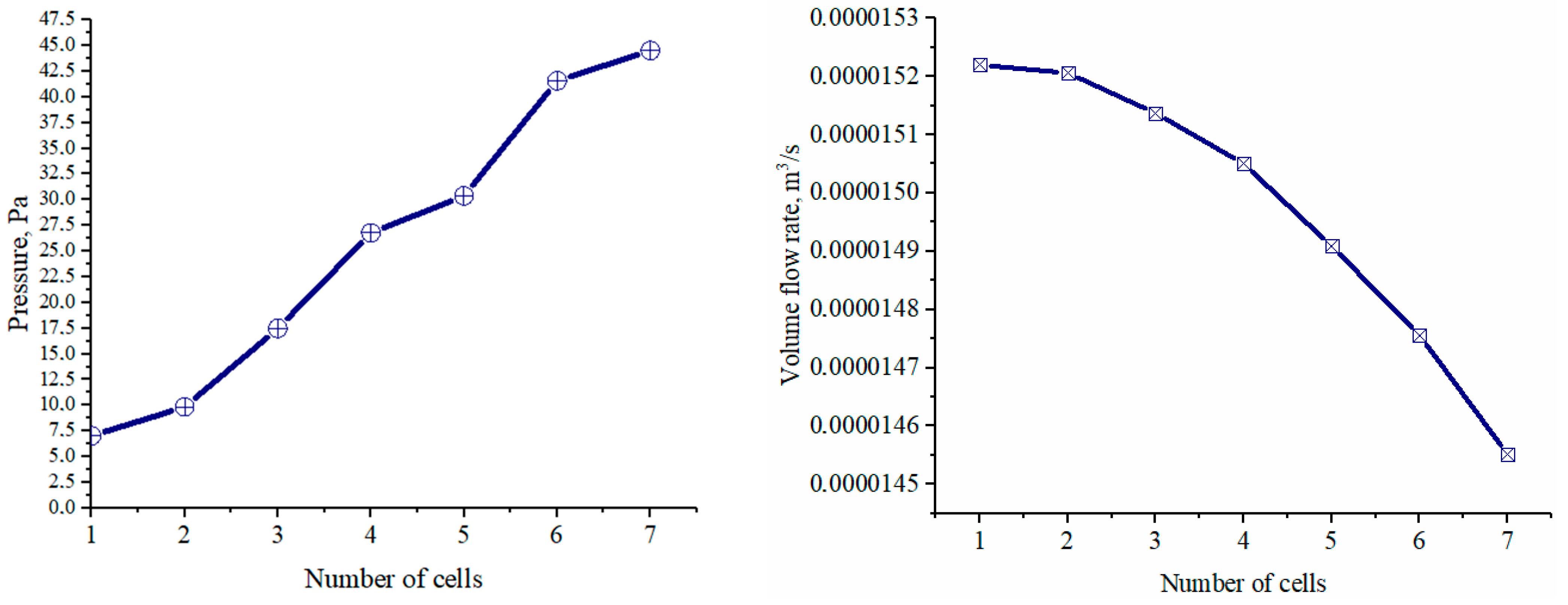


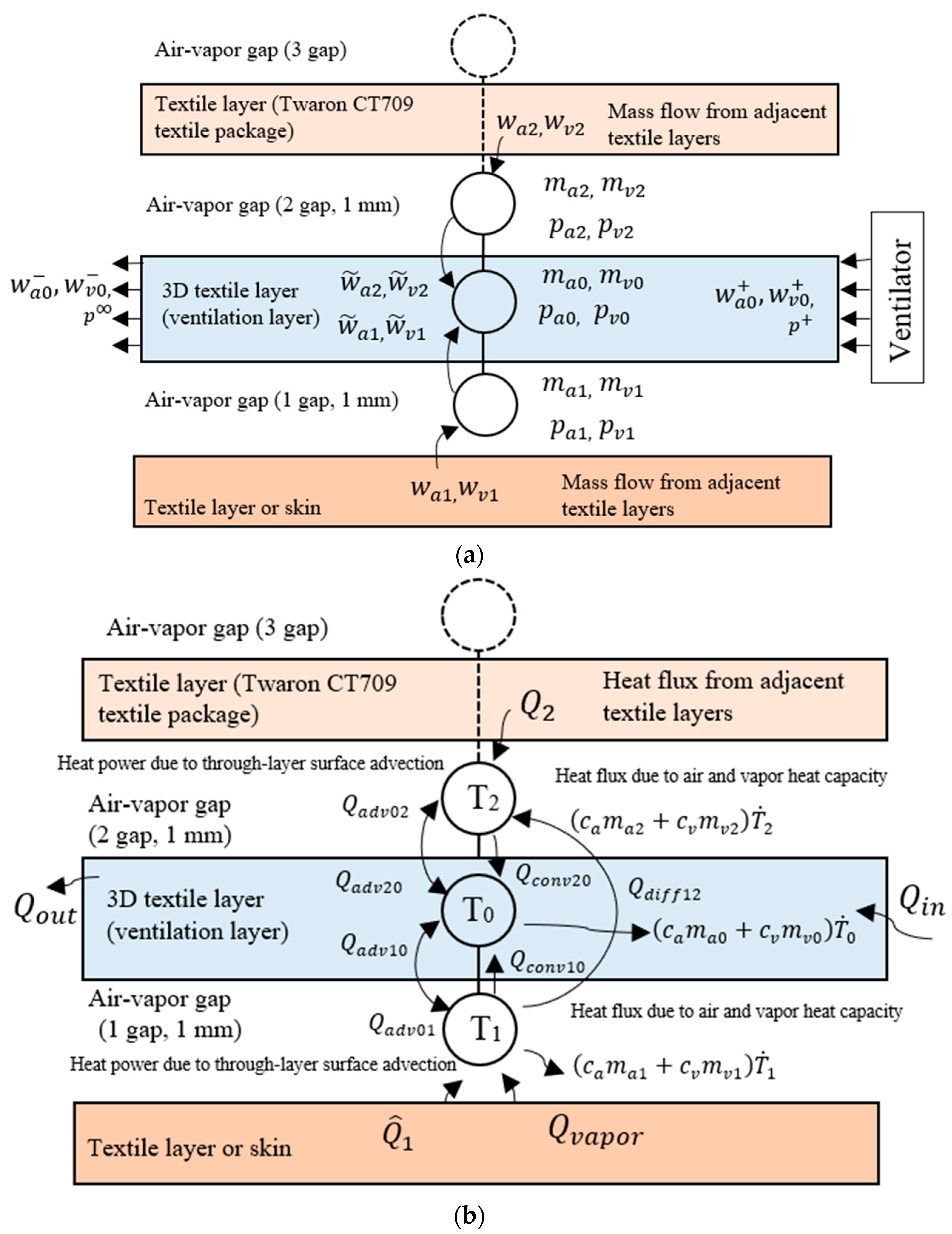

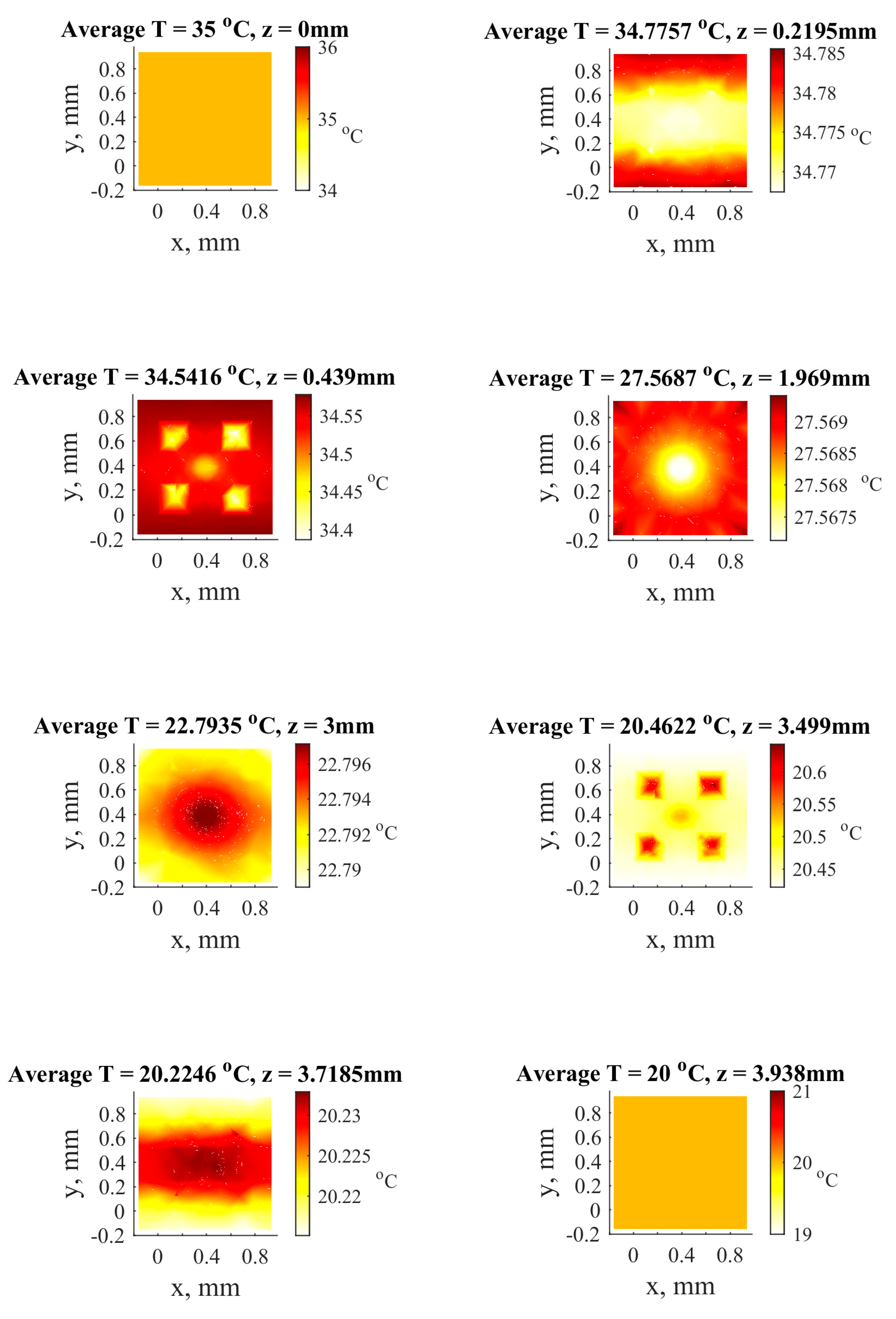
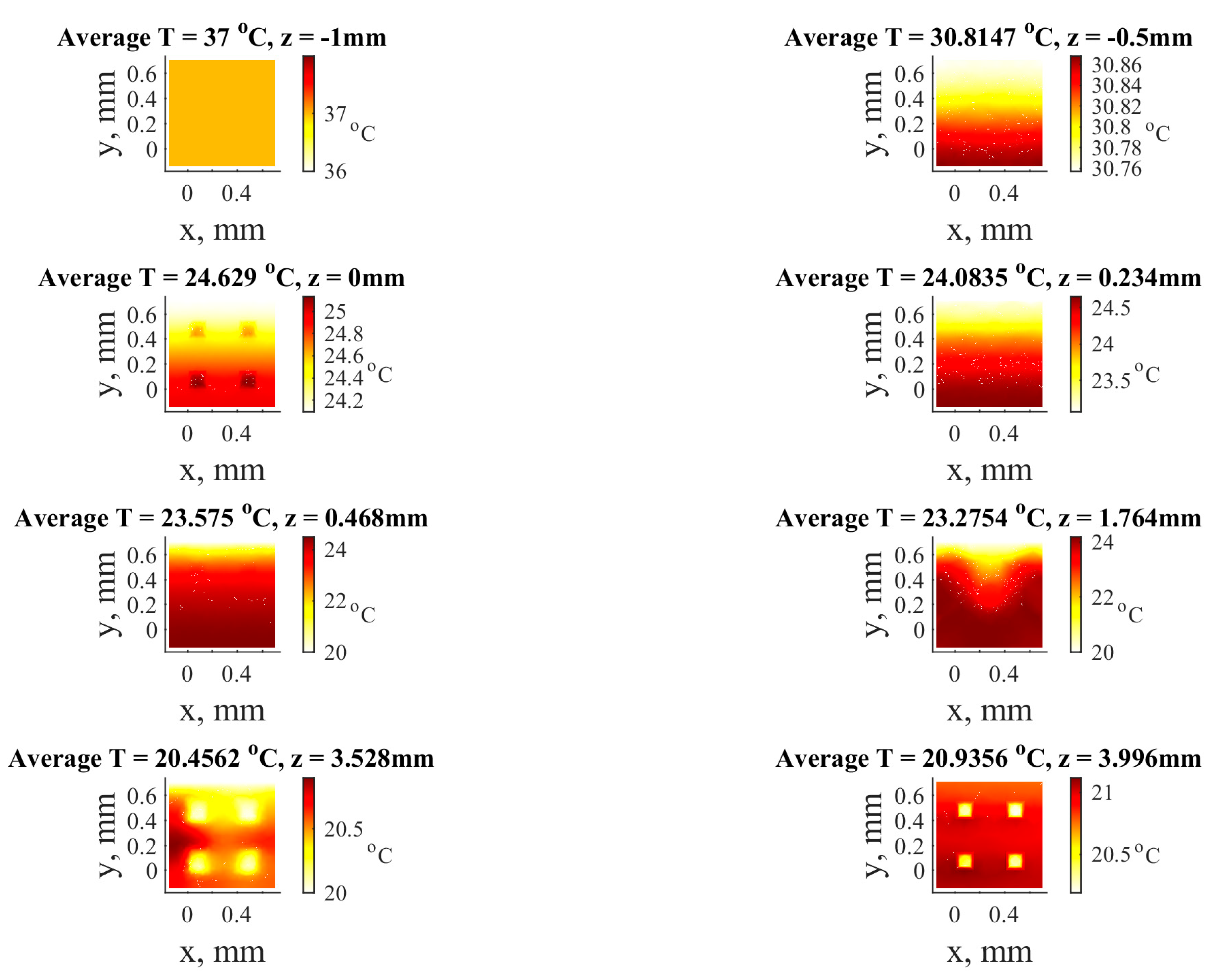
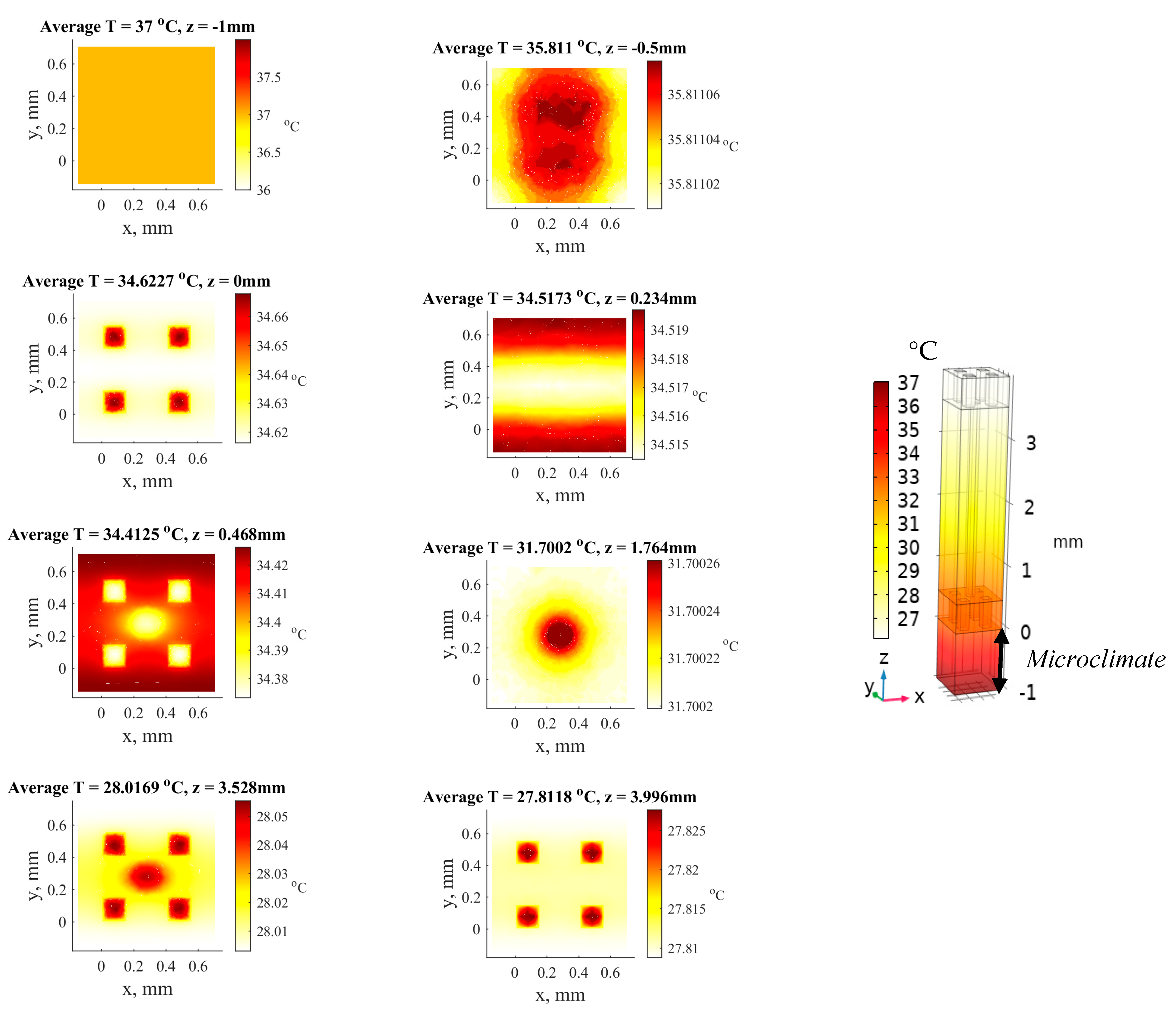
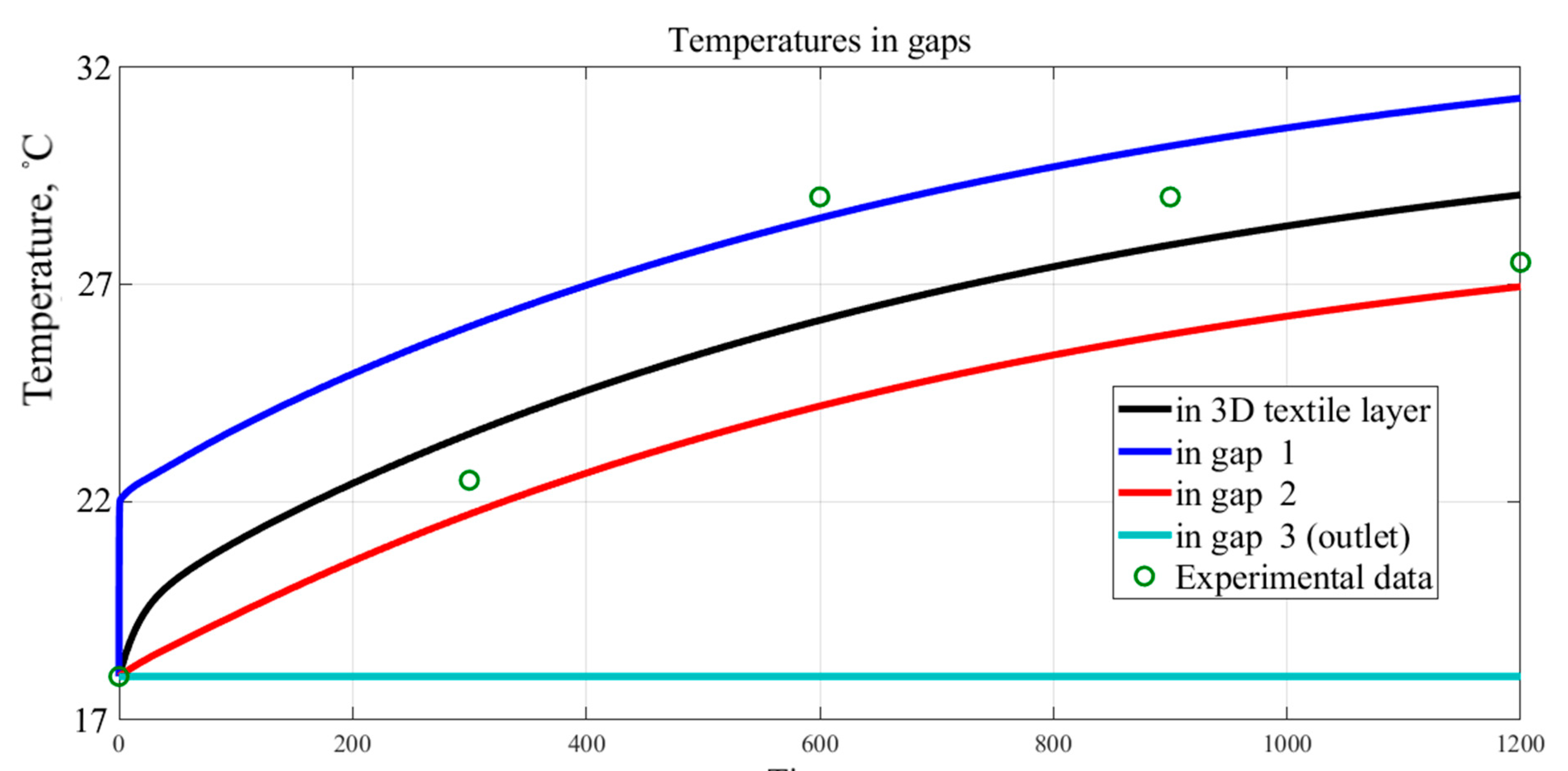
| Model | Length and Width of Domain a × b (mm) | Height of Air Domain H (mm) | The Thickness of the Textile Layer h (mm) | Length and Width of Pore c × d (mm) | Distance between Two Layers of Textile e (mm) |
|---|---|---|---|---|---|
| Model 1_c | 1.1 × 1.1 | 10 | 0.439 | 0.263 × 0.263 | - |
| Model 1_e | 1.1 × 1.1 | 10 | 0.439 | 0.263 × 0.263 | 3.06 |
| Model 2_e | 0.98 × 0.98 | 10 | 0.438 | 0.195 × 0.195 | 3.06 |
| Model 3_e | 0.85 × 0.85 | 10 | 0.468 | 0.155 × 0.155 | 3.06 |
| Interface | Surface | Boundary Condition | Description |
|---|---|---|---|
| Fluid flow | on ∂Ωinlet | Qsv- standard flow rate is 0.8 dm3/min. | Inlet boundary condition was used to apply the mass flow rate, where stands for the fluid flow domain boundary thickness, the standard density is defined as In this investigation, the standard temperature Tst = 20 °C, mean molar mass of the fluid (0.032 kg/mol), R—the universal molar gas constant, and —the standard pressure 1 [atm] [40]. |
| on ∂Ωoutlet_1, on ∂Ωoutlet_2. | , | Outlet on ∂Ωoutlet is a boundary where the fluid (net) outflows from the domain. The term stands for “suppress backflow”. | |
| on ∂Ωt, on ∂Ωair | Wall condition: no-slip. The fluid velocity is zero. This boundary condition is used as the default. | ||
| on ∂Ωe | Wall condition. The wall condition slip was applied on ∂Ωe surface. | ||
| Heat flow | on ∂Ωinflow_1 | T = 37 °C | Temperature. The inlet constant temperature was set to represent human skin temperature. |
| on ∂Ωinflow_2 | T = 20 °C | Temperature. The inlet constant temperature was set to represent generated from the thermoelectric module. | |
| on ∂Ωoutflow_1 | Outflow. In a model with convective heat transfer, this condition states that the only heat transfer occurring across the boundary is by convection. The temperature gradient in the normal direction is zero [40]. | ||
| on ∂Ωoutflow_2 | Heat flux. The h denotes a heat transfer coefficient. The h = 8.9646 W/(K·m2) was selected from Table 3, which was numerically predicted. is the external temperature. It was assumed that °C. | ||
| Thermal insulation. This boundary condition is used as the default. |
| Interface | Surface | Boundary Condition | Description |
|---|---|---|---|
| Fluid flow | on ∂Ωinlet | Qsv- 0.000014716 m3/s. | Inlet boundary condition was used to apply the mass flow rate, where the standard density is defined as mean molar mass of the fluid and —the standard molar volume. |
| on ∂Ωoutlet_1 | Outlet on ∂Ωoutlet_1, the flow rate of 0.000014552 m3/s was applied. |
| Model | Rct, K·m2/W | h, W/(K·m2) | One-Layer Thickness, mm | The Height of the Model x_e, mm |
|---|---|---|---|---|
| Model 1_e | 0.11725 | 8.5287 | 0.439 | 3.938 |
| Model 2_e | 0.11455 | 8.7298 | 0.438 | 3.936 |
| Model 3_e | 0.11155 | 8.9646 | 0.468 | 3.996 |
| Mass Flow Rate | hmicrolayer, W/(K·m2) | htotal, W/(K·m2) |
|---|---|---|
| No ventilation | 25.61 | 6.6368 |
| With ventilation | 25.603 | 19.747 |
Disclaimer/Publisher’s Note: The statements, opinions and data contained in all publications are solely those of the individual author(s) and contributor(s) and not of MDPI and/or the editor(s). MDPI and/or the editor(s) disclaim responsibility for any injury to people or property resulting from any ideas, methods, instructions or products referred to in the content. |
© 2023 by the authors. Licensee MDPI, Basel, Switzerland. This article is an open access article distributed under the terms and conditions of the Creative Commons Attribution (CC BY) license (https://creativecommons.org/licenses/by/4.0/).
Share and Cite
Gadeikytė, A.; Abraitienė, A.; Barauskas, R. Application of Combined Micro- and Macro-Scale Models to Investigate Heat and Mass Transfer through Textile Structures with Additional Ventilation. Mathematics 2023, 11, 2532. https://doi.org/10.3390/math11112532
Gadeikytė A, Abraitienė A, Barauskas R. Application of Combined Micro- and Macro-Scale Models to Investigate Heat and Mass Transfer through Textile Structures with Additional Ventilation. Mathematics. 2023; 11(11):2532. https://doi.org/10.3390/math11112532
Chicago/Turabian StyleGadeikytė, Aušra, Aušra Abraitienė, and Rimantas Barauskas. 2023. "Application of Combined Micro- and Macro-Scale Models to Investigate Heat and Mass Transfer through Textile Structures with Additional Ventilation" Mathematics 11, no. 11: 2532. https://doi.org/10.3390/math11112532
APA StyleGadeikytė, A., Abraitienė, A., & Barauskas, R. (2023). Application of Combined Micro- and Macro-Scale Models to Investigate Heat and Mass Transfer through Textile Structures with Additional Ventilation. Mathematics, 11(11), 2532. https://doi.org/10.3390/math11112532







